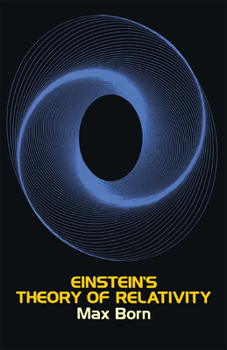Einstein's Theory of Relativity
Select Format
Select Condition 
Book Overview
A book in which one great mind explains the work of another great mind in terms comprehensible to the layman is a significant achievement. This is such a book. Max Born is a Nobel Laureate (1955) and one of the world's great physicists: in this book he analyzes and interprets the theory of Einsteinian relativity. The result is undoubtedly the most lucid and insightful of all the books that have been written to explain the revolutionary theory that marked the end of the classical and the beginning of the modern era of physics. The author follows a quasi-historical method of presentation. The book begins with a review of the classical physics, covering such topics as origins of space and time measurements, geometric axioms, Ptolemaic and Copernican astronomy, concepts of equilibrium and force, laws of motion, inertia, mass, momentum and energy, Newtonian world system (absolute space and absolute time, gravitation, celestial mechanics, centrifugal forces, and absolute space), laws of optics (the corpuscular and undulatory theories, speed of light, wave theory, Doppler effect, convection of light by matter), electrodynamics (including magnetic induction, electromagnetic theory of light, electromagnetic ether, electromagnetic laws of moving bodies, electromagnetic mass, and the contraction hypothesis). Born then takes up his exposition of Einstein's special and general theories of relativity, discussing the concept of simultaneity, kinematics, Einstein's mechanics and dynamics, relativity of arbitrary motions, the principle of equivalence, the geometry of curved surfaces, and the space-time continuum, among other topics. Born then points out some predictions of the theory of relativity and its implications for cosmology, and indicates what is being sought in the unified field theory. This account steers a middle course between vague popularizations and complex scientific presentations. This is a careful discussion of principles stated in thoroughly acceptable scientific form, yet in a manner that makes it possible for the reader who has no scientific training to understand it. Only high school algebra has been used in explaining the nature of classical physics and relativity, and simple experiments and diagrams are used to illustrate each step. The layman and the beginning student in physics will find this an immensely valuable and usable introduction to relativity. This Dover 1962 edition was greatly revised and enlarged by Dr. Born.
Format:Paperback
Language:English
ISBN:0486607690
ISBN13:9780486607696
Release Date:June 1962
Publisher:Dover Publications
Length:400 Pages
Weight:0.91 lbs.
Dimensions:0.9" x 5.4" x 8.4"
Customer Reviews
5 ratings
The Lament
Published by Thriftbooks.com User , 18 years ago
Dr. Einstein oft lamented that so few really understood his theories. He said that perhaps there was one or maybe two people that understood. It seems to me Max Born must be one of them. His work simplifies as much as possible without sacrificing the level of knowledge needed to grasp the topic and begin to see its implications. It is a complex topic but Max Born rises to the occasion to give us at least a glimpse into this important subject.
A Gem
Published by Thriftbooks.com User , 23 years ago
At times notation can be a distraction, at other times notation can cause confusion, as in E & M most notably. Max Born's book is a gem and if you can get around the mild distractions and focus on the ideas then you may even get around the paradoxes in Relatively, where "common sense" is a distraction.Some gifted people can write and explain well the most complex ideas some cannot. Max Born succeeds one of the best popular books on Relativity.
reply to the guy from the schwarzchild radius
Published by Thriftbooks.com User , 23 years ago
The notation comes from German: K for Kraft (force), b for Beschleuningung (acceleration), m for Masse (mass). It might be outdated, but that does in no way disqualify the content of a text. As for learning calculus in order to understand relativity: I believe Einstein once said he could explain relativity (maybe he meant special relativity) to a barmaid. Knowing calculus and differential geometry (for general relativity) would indeed provide one with a much deeper understanding of the theory, but one can get a good feel for the subject without it. So if you are looking for a basic introduction to relativity don't discard this one for those reasons. One good reason to choose this book is that it presents relativity in its natural context of electrodynamics, which really gives one a much clearer perspective, I believe.
Best one yet
Published by Thriftbooks.com User , 26 years ago
Born does one of the best jobs of anyone of explaining relativity to the interested person. The first half deals primarily with Newtonian mechanics and he later applies this under more extreme circumstances to bring out Einstein's theory. Born also addresses this subject very well mathematically (which is good, because otherwise no one could understand the subject), although his variables may be confusing initially as he uses letters which are not convention.All in all it was probably the best book on relativity that I've read, and that's pretty good.
An excellent review of classical physics and relativity
Published by Thriftbooks.com User , 26 years ago
Born spends the first half of the book developing an historical perspective of the time at which Einstein was grappling with Relativity. He leads us through all the major domains of Physics and arrives at Einstein's point of departure.In the second half of the book, a full and complete review of Relativity is given.Extensive use of physics equations is made throughout the book however for the reader looking purely for the historical perspective these can be safely assumed.





